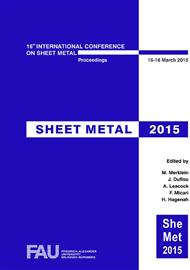[1]
N.N.: http: /ec. europa. eu/clima/policies/transport/vehicles/cars/index_en. htm (16. 09. 2014).
Google Scholar
[2]
R.S. Mishra, Z.Y. Ma: Friction stir welding and processing, Materials Science and Engineering R 50 (2005), 1–78.
Google Scholar
[3]
G. Buffa, J. Hua, R. Shivpuri, L. Fratini: Design of the friction stir welding tool using the continuum based FEM model, Materials Science and Engineering A 419 (2006), 381–388.
DOI: 10.1016/j.msea.2005.09.041
Google Scholar
[4]
E.L. Odenberger, J. Hertzman, P. Thilderkvist, M. Merklein, A. Kuppert, T. Stöhr, J. Lechler, M. Oldenburg,: Thermo mechanical sheet metal forming of aero engine components in Ti-6Al-4V–PART 1, Material characterisation. Int. J. Mater Form. (2012).
DOI: 10.1007/s12289-012-1093-8
Google Scholar
[5]
ASTM, 2005. Test method for shear testing of thin aluminum alloy products. ASTM Int.
Google Scholar
[6]
D. Staud, M. Merklein, In: M. Borsutzki, S. Geisler, (Eds. ), Zug-Druck-Versuche an Miniaturproben zur Erfassung von Parametern für kinematische Verfestigungsmodelle. Tagungsband Werkstoffprüfung, Düsseldorf, (2009), 211–218.
Google Scholar
[7]
S. Bouvier, H. Haddadi, P. Levée, C. Teodosiu: Simple shear tests: experimental techniques and characterization of the plastic anisotropy of rolled sheets at large strains, J. Mater. Process. Technol. 172, (2006), 96–103.
DOI: 10.1016/j.jmatprotec.2005.09.003
Google Scholar
[8]
M. Merklein, M. Biasutti: Forward and reverse simple shear test experiments for material modeling in forming simulations, In: G. Hirt, A.E. Tekkaya, (Eds. ), International Conference on Technology of Plasticity, Aachen. (2011), 702–707.
Google Scholar
[9]
M. Merklein, M. Biasutti: Development of a Biaxial Tensile Machine for Characterization of Sheet Metals. J. Mater. Process. Tech. (2013) 213, 939-946.
DOI: 10.1016/j.jmatprotec.2012.12.005
Google Scholar
[10]
F. Barlat, Y. Maeda, K. Chung, M. Yanagawa, J.C. Brem, Y. Hayashida, D.J. Lege, K. Matsui, S.J. Murtha, S. Hattori, R.C. Becker, S. Makosey: Yield function development for aluminum alloy sheet, J. Mech. Phys. Solids, 45, 1727, (1997).
DOI: 10.1016/s0022-5096(97)00034-3
Google Scholar
[11]
R. Hill: Costitutive modelling of orthotropic plasticity in sheet metals. J. Mech. Phys. Solids, 38, (1990), pp.405-417.
Google Scholar
[12]
F. Barlat, J. Lian: Plastic behavior and stretchability of sheet metals. Part I: A yield function for orthotropic sheets under plane stress conditions, Int. J. Plast. 5 (1989) 51–66.
DOI: 10.1016/0749-6419(89)90019-3
Google Scholar
[13]
H. Aretz: Applications of a new plane stress yield function to orthotropic steel and aluminium sheet metals, Modell. Simulat. Mater. Sci. Eng. 12 (2004) 491–509.
DOI: 10.1088/0965-0393/12/3/010
Google Scholar
[14]
A.V. Hershey: The plasticity of an isotropic aggregate of anisotropic face-centered cubic crystals, J. Appl. Mech. Trans. ASME 21 (1954) 241–249.
DOI: 10.1115/1.4010900
Google Scholar
[15]
W.F. Hosford: A generalized isotropic yield criterion, J. Appl. Mech. Trans. ASME 39 (1972) 607–609.
DOI: 10.1115/1.3422872
Google Scholar
[16]
N. N.: Metallic materials - Tensile testing - Part 2: Method of test at elevated temperature (ISO 6892-2: 2011), Beuth-Verlag, Germany, (2011).
Google Scholar
[17]
J. E. Hockett, O. D. Sherby: Large strain deformation of polycrystalline metals at low homologous temperatures. In: Journal of the Mechanics and Physics of Solids, 23 (1975), 87-98.
DOI: 10.1016/0022-5096(75)90018-6
Google Scholar
[18]
E. G. Dieter: Mechanical Metallurgy. SI Metric Edition. London, New York, San Francisco: McGraw-Hilli Book Company, (1928).
Google Scholar


